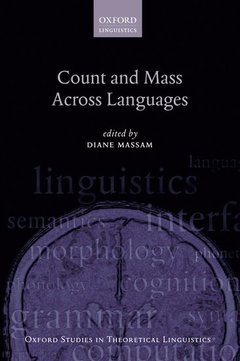Description
Count and Mass Across Languages
Oxford Studies in Theoretical Linguistics Series, Vol. 42
Coordinator: Massam Diane
Language: English
Subject for Count and Mass Across Languages:
Count and mass across languages (paperback) (series: oxford studies in theoretical linguistics)
Publication date: 09-2012
332 p. · 16.3x23.3 cm · Hardback
Publication date: 09-2012
332 p. · 16.3x23.3 cm · Hardback
Count and mass across languages (hardback) (series: oxford studies in theoretical linguistics)
Publication date: 09-2012
332 p. · 16.2x24.1 cm · Paperback
Publication date: 09-2012
332 p. · 16.2x24.1 cm · Paperback
Description
/li>Contents
/li>Biography
/li>
This volume explores the expression of the concepts count and mass in human language and probes the complex relation between seemingly incontrovertible aspects of meaning and their varied grammatical realizations across languages. In English, count nouns are those that can be counted and pluralized (two cats), whereas mass nouns cannot be, at least not without a change in meaning (#two rices). The chapters in this volume explore the question of the cognitive and linguistic universality and variability of the concepts count and mass from philosophical, semantic, and morpho-syntactic points of view, touching also on issues in acquisition and processing. The volume also significantly contributes to our cross-linguistic knowledge, as it includes chapters with a focus on Blackfoot, Cantonese, Dagaare, English, Halkomelem, Lithuanian, Malagasy, Mandarin, Ojibwe, and Persian, as well as discussion of several other languages including Armenian, Hungarian, and Korean. The overall consensus of this volume is that while the general concepts of count and mass are available to all humans, forms of grammaticalization involving number, classifiers, and determiners play a key role in their linguistic treatment, and indeed in whether these concepts are grammatically expressed at all. This variation may be reflect the fact that count/mass is just one possible realization of a deeper and broader concept, itself related to the categories of nominal and verbal aspect.
1. The Count Mass Distinction: Issues and Perspectives. 2. Lexical Nouns are Both +MASS and +COUNT, but They are Neither +MASS nor +COUNT. 3. Aspects of Individuation. 4. Collectives in the Intersection of Mass and Count Nouns: A Cross-Linguistic Account. 5. Individuation and Inverse Number Marking in Dagaare. 6. General Number and the Structure of DP. 7. Plural Marking Beyond Count Nouns. 8. Aspectual Effetcs of a Pluractional Suffix: Evidence From Lithuanian. 9. Decomposing the Mass/count Distinction: Evidence from languages that lack it. 10. On the Mass/count Distinction in Ojibwe. 11. Counting and Classifiers. 12. Countability and Numeral Classifiers in Mandarin Chinese. 13. Semantic Triggers, Linguistic Variation, and the Mass-Count Distinction. 14. Classifying and Massifying Incrementally in Chinese Language Comprehension. References. Index.
Diane Massam is Professor of Linguistics at the University of Toronto where she served as Chair of Linguistics from 2002 to 2008. Her research focus is on syntactic theory, in the areas of argument structure, case, predication, and word order, working mainly on Niuean, a Polynesian language. She is the co-editor of Ergativity: Emerging issues (Springer 2006) and has published papers in many journals such as Lingua, Oceanic Linguistics, Natural Language and Linguistic Theory, English Language and Linguistics, and Syntax. She has held several research grants from the Social Sciences and Humanities Research Council of Canada, and was co-editor of Squibs for Linguistic Inquiry (1998-2002), honorary research fellow at the University of Auckland (2001), visiting professor at Harvard University (2006), and an Erskine Fellow at the University of Canterbury, New Zealand (2010).
© 2024 LAVOISIER S.A.S.
These books may interest you

Semantics for Counting and Measuring 106.56 €



